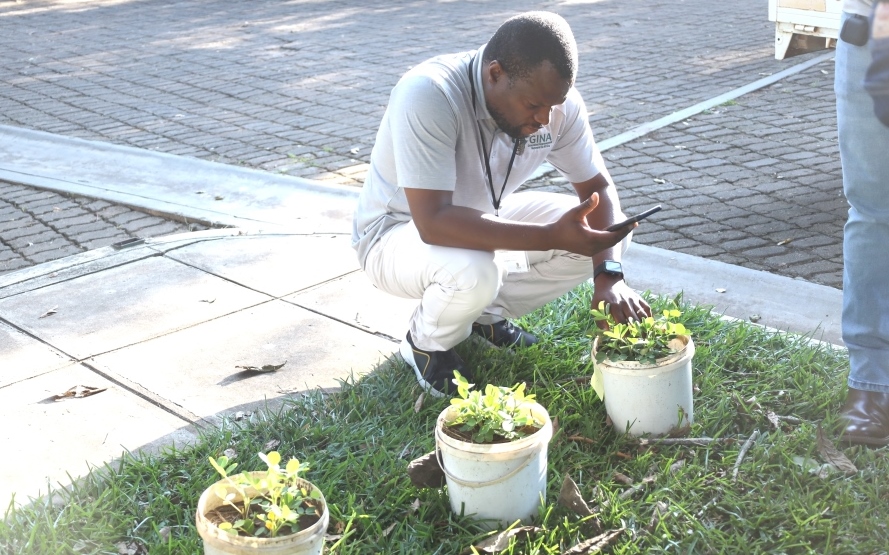
High hopes for new groundnut variety
 The humble peanut is set to shine in Malawi, thanks in part to a graduate of the African Centura for Crop Improvement. Dr Justus Chintu (pictured left), who graduated in 2013 from the University of KwaZulu-Natal, co-led the development and recent release of a promising new groundnut variety with Dr James Mwololo from the International Crops Research Institute for the Semi-Arid Tropics (ICRISAT).
The humble peanut is set to shine in Malawi, thanks in part to a graduate of the African Centura for Crop Improvement. Dr Justus Chintu (pictured left), who graduated in 2013 from the University of KwaZulu-Natal, co-led the development and recent release of a promising new groundnut variety with Dr James Mwololo from the International Crops Research Institute for the Semi-Arid Tropics (ICRISAT).
Groundnut is a valuable crop for farmers because of its high edible oil and protein content. Developed and released by ICRISAT and the Malawi government, the new variety, known as CG18, is a Spanish groundnut bred to satisfy the changing needs of small-scale farmers and the broader market.
In a press release, ICRISAT described CG18 as tackling “climate stress, pests, and market demands. It stands out for its resilience to climate shocks, including drought and heat stress, and demonstrates strong resistance to groundnut rosette disease, one of the most devastating diseases affecting groundnut yields in the region.” The variety also boasts high yields and, according to Chintu, was “earmarked as a variety that can be exported for the chocolate-bar-making-industry, owing to its seed size and colour.”
Chintu was well placed to contribute to developing this high-performance variety, having worked on the release of more than 10 new groundnut varieties before it. His role was to evaluate lines initially to assess performance in yield, disease resistance (especially Groundnut rosette disease) and drought tolerance. He was also involved in getting feedback from farmers and economists, developing a proposal with the ICRISAT breeder and submitting it to the agricultural technology clearing committee.
Chintu is the chief research scientist – plant breeding at Chitedze Agricultural Research Station in Malawi, and he is also an acting national research coordinator for the legumes, fibre and oilseed crops in the department. He spent his childhood at Kasinthula Research Station in southern Malawi, where his mother was a teacher and his father was a sorghum and millet breeder, working for the Department of Agriculture research services. “I grew up thinking I would like to be like him,” says Chintu, and when he finished school, he started a BSc in agriculture, crop science in Malawi, finishing in 2000.
This was followed by a master’s degree in crop science and management at the University of Nottingham in the UK, after being awarded a Joint Chevening scholarship. He completed his master’s and returned to Malawi in 2006. The following year, he was offered a scholarship to do a PhD, starting in January 2008, at the ACCI.
Chintu had an interest in groundnuts before starting his PhD, having worked for the Department of Crop Development after finishing his undergraduate degree. Part of that job involved engaging with farmers about their crop challenges. “Through that, my interest grew to do any research that would assist farmers, and I would also continue the legacy of my dad,” he says. The title of his thesis was “Breeding groundnut for resistance to rosette disease and its aphid vector”, and he started his research in 2009.
He had determined through doing a survey with groundnut farmers that Rosette disease and aflatoxin were their main challenges, and he approached ICRISAT for promising lines that he used to make crosses. “I studied the inheritance of Rosette disease and even did genotyping of all materials that I used in my study,” he says.

“I was fortunate that I was attached to ICRISAT, which has offices in Chitedze and does groundnut research. I learned a lot, and I am continuing the work,” he says. “After I finished my studies, I formally joined Chitedze Research Station as a plant breeder in 2013. I found projects which were ongoing. Through them, we selected lines which were better performing and, together with the team from ICRISAT, developed a proposal which I presented in 2014 for the release of seven new groundnut varieties. These were the first groundnut varieties to be released in nine years,” he says.
“I continued with the breeding and evaluation of materials, and since then, have released four more groundnut varieties. I also helped a company called Pyxus to develop a proposal, which I presented for releasing four of their varieties.”
He says when varieties with potential for release are identified, they are taken to farmers for feedback that can be included in the design of a breeding program. This is an important step in the process. “New varieties have been released, but what we tend to see is that farmers cling to old varieties. You may think that once a variety is rosetteresistant, farmers will like it, but then you see that they have their own interests. That’s where it becomes imperative to involve them in the whole process.”
Chintu is currently working on a project funded by A Green Revolution in Africa (AGRA), looking at accelerating the release of nutrient-dense (high oleic content) and drought-tolerant groundnut varieties. The project started this year and should be completed in 2027. He is also working with CIMMYT on regional trials to identify disease-tolerant and drought-tolerant materials, and with the International Atomic Energy Agency to develop mutant varieties of groundnut, soybean and pigeonpea.

